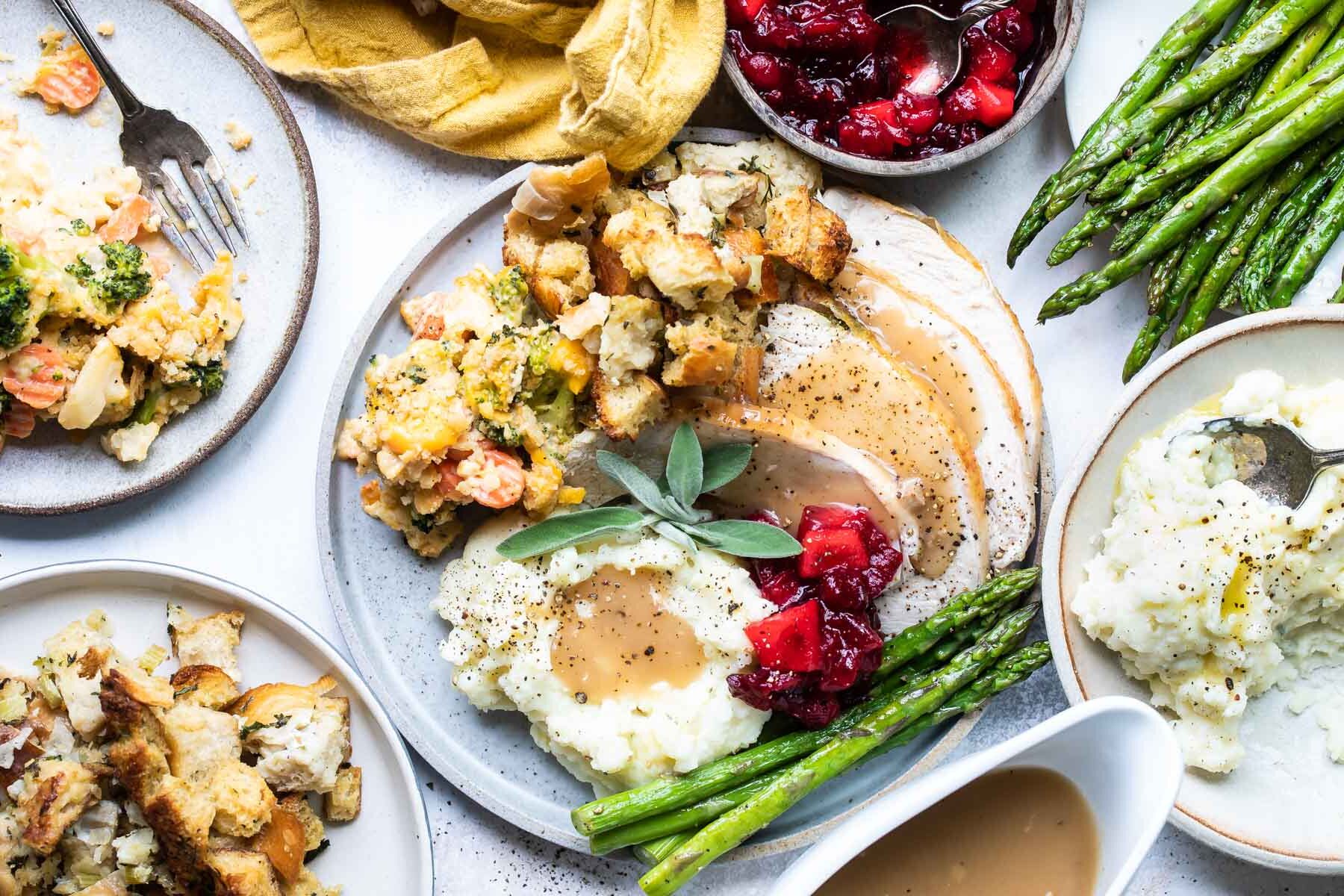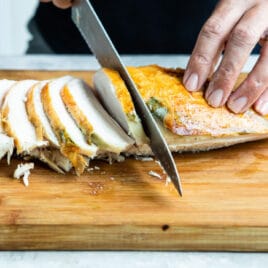Follow this simple, methodical tutorial for How to Carve a Turkey. Using a sharp carving knife, carve one side completely before moving on to the second side. Anyone can do it!.
It’s time to carve your ideal Thanksgiving bird after it’s rested and taken out of the oven. Arranging a perfectly carved turkey on a serving plate at the dinner table is a visually stunning and convenient arrangement for your guests.
It’s easy to do, too. Although carving a turkey may seem daunting, you can approach the bird methodically once you grasp the technique. Work on one side at a time and you’ll be done in no time.
Carving a perfectly cooked turkey breast is an art form and knowing how to slice it against the grain is the key to achieving tender, flavorful results. This guide will walk you through the process step-by-step, ensuring you impress your guests with succulent slices every time.
Why Cut Against the Grain?
Cutting against the grain means slicing perpendicular to the direction of the muscle fibers. This simple technique makes a big difference in the texture of the meat, resulting in tender and easier-to-chew slices. By breaking down the tough connective tissues, you maximize the tenderness of each bite.
Step-by-Step Guide
1 Rest the Cooked Turkey Breast:
Allow the turkey breast to rest for about 10-15 minutes before slicing. This allows the juices to redistribute, ensuring a moist and flavorful outcome.
2, Locate the Grain:
Look for the long strands of muscle fibers running across the surface of the turkey breast. They usually align in one direction. You’ll be cutting perpendicular to these fibers.
3. Grab a Sharp Knife:
Use a sharp carving knife or a chef’s knife for clean and precise cuts. A dull knife can tear the meat and make it harder to cut against the grain.
4. Make Your First Cut:
Start by making a horizontal cut across the turkey breast, near one end. This creates a flat surface for stability during the slicing process.
5. Slice Against the Grain:
Begin at one end and work your way across the meat in smooth, even motions. Remember to keep the knife perpendicular to the grain for optimal results.
6. Repeat as Needed:
Continue slicing against the grain until you’ve cut through the entire turkey breast. Take your time and maintain a consistent slicing direction for uniform, tender slices.
Tips for Perfect Slices
- Use a carving fork: This helps stabilize the turkey breast while you slice, making it easier to achieve consistent cuts.
- Adjust your cutting angle: If the slices are still tough, try adjusting the cutting angle slightly until you achieve desired tenderness.
- Practice patience: Cutting against the grain requires precision and patience. Take your time and focus on maintaining a steady hand throughout the process.
- Invest in a quality carving knife: A sharp and high-quality carving knife will make all the difference in achieving clean, effortless slices.
Now that you know the secrets of cutting turkey breast against the grain, you can impress your guests with tender and succulent slices of meat. Remember to embrace the process, enjoy the aroma, and savor the deliciousness of a well-carved turkey breast!
FAQ:
What does it mean to cut turkey breast against the grain?
Cutting against the grain means slicing the turkey breast perpendicular to the muscle fibers. This technique helps yield tender and easy-to-chew slices of meat.
How does cutting against the grain affect the texture of the turkey breast?
Cutting against the grain significantly improves the tenderness of the turkey breast. By slicing against the grain, you shorten the individual muscle fibers, resulting in a more tender and less chewy texture.
What tools do I need to cut turkey breast against the grain?
You’ll need a sharp chef’s knife or carving knife, a cutting board, and a meat fork or tongs to hold the turkey steady while cutting.
Should I cook the turkey breast before cutting against the grain?
Yes, it’s important to cook the turkey breast fully before attempting to cut it against the grain. Cutting raw meat against the grain can be very challenging and may result in uneven cuts.
Can I cut turkey breast against the grain without a cutting board?
While a cutting board is highly recommended for safety and stability, you can use a plate or a clean, flat surface as an alternative. Just ensure the surface is sturdy and won’t damage your knife.
Are there any specific tips for cutting against the grain of turkey breast?
Yes, there are a few useful tips to keep in mind. First, let the turkey breast rest for a few minutes before slicing to allow the juices to redistribute. Secondly, always use smooth, fluid motions when cutting against the grain. Lastly, be sure to use a sharp knife to ensure clean cuts.
Is cutting against the grain necessary for every turkey breast recipe?
While cutting against the grain is generally recommended for optimal tenderness, it may not be necessary for certain turkey breast recipes. If the recipe calls for the turkey to be shredded or chopped, cutting against the grain may not be as crucial. However, for sliced or carved turkey breast, cutting against the grain is highly recommended to achieve the best texture.
Recipe tips and variations
- Yield: Aim for a turkey weight of one and a half pounds per person (some weight comes from bones). The recipe suggests that a 15-pound turkey will serve roughly 12 people, or 1 ½ cups of turkey per person, for a total of 18 cups. The math is 12 people x 1. 25 pounds per person = 15-pound turkey.
- Storage: For up to four days, keep leftovers covered in the refrigerator.
- Make ahead: Use my simple Make Ahead Turkey recipe to start your Thanksgiving preparations early. First, roast, carve, and freeze the turkey in its juices. Then thaw, reheat, and make the gravy.
- Table-side carving: If you would rather handle everything backstage and carve the turkey at the table, use this technique. Make a base cut by carving a deep horizontal incision through the breast toward the bone, just above the thigh and shoulder joints. Beginning close to the breastbone, make thin vertical slices, ending with a base cut for each slice.
- The Ultimate Turkey Guide: Prepare the most delicious Thanksgiving meal or Sunday supper ever Learn the basics of purchasing, defrosting, brining, and cooking turkeys. You’ll also discover how simple it is to prepare turkey gravy and broth from pan drippings.
- Because you might be cooking a slightly smaller or larger turkey, roasting times can vary. Roasting an unstuffed turkey at 325 degrees takes about 15 minutes per pound. Nonetheless, an excellent meat thermometer—165 degrees at the thickest part of the thigh—is the best tool for determining whether a turkey has been properly roasted.
- Roasted Turkey Breast: Try my best roast turkey breast recipe for a Sunday dinner or a small Thanksgiving menu. The skin is incredibly crisp from a dry brine and basting, and the meat is juicy and flavorful.
- Slow Cooker Turkey Breast: This recipe uses no oven space and produces a delicious, tender bird.
- Make turkey broth or soup: Use your leftover turkey carcass to make the best leftover turkey noodle soup you’ve ever tasted or a pot of delectable homemade turkey broth.

The majority of modern recipes discourage stuffing turkeys because it compromises food safety and results in a bird that cooks more evenly. Should you choose to stuff your turkey, mix the wet and dry ingredients right before stuffing the bird’s cavity. Make sure any raw meat, poultry, or shellfish that you use for the stuffing has been thoroughly cooked beforehand. Do not stuff a bird with cooked stuffing. Loosely pack the body and neck cavities using a large spoon or your hands (do not pack it tightly because the stuffing expands while it cooks). Truss the main cavity with trussing pins to keep the stuffing inside. The stuffing must register 165 degrees on an internal thermometer to be safe to eat. For more information, see the USDA website. Stuffing chicken and Cornish hens is also discouraged.
Working with Meat and Fish
Working with Meat and Fish
Working with Meat and Fish
Stock, Sauce, and Spread Recipes

